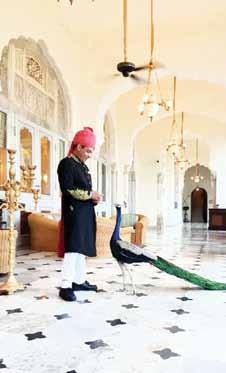
13 minute read
Part 1: Heritage Palaces
Part 1: Heritage Palaces & Rajbaris of Eastern India
In a 29th floor lounge room overlooking of heritage properties in eastern India went unSydney’s Hyde Park, here in Australia, I noticed until few years back. I never bothered was reading the elegant One Barangaroo about exploring eastern Indian heritage properbrochure of the Crown Residences. The ties as places to stay. Even though, guests from luxurious address with its extraordinary SydAustralia, the United States and Sweden stayed ney views, London architecture and Manhattan and appreciated our old Halder Bari property interiors will open at the end of 2020. ‘Kamala Niwas’ in Ballygunge, Kolkata.
This mammoth luxurious development on the east coast of Australia is providing employment to many, a luxury residence for a privileged few, and will have a significant impact on New South Wales state tourism once finished. Then, I realised that One Barangaroo will become a heritage property of tomorrow as is the case with many luxury properties in the Indian subcontinent.
For centuries in India, affluent families built mammoth luxury residences. These palaces of India are the heritage properties of today, and are an integral part of Indian tourism.
India had more than 550 princely states all of which owned luxury palaces, such as Belgadia Palace, Odisha, Wasif Manzil Palace, West Bengal and Neer Mahal Palace, Tripura. Palaces are located in diverse geographical locations in eastern India, from those surrounded by magnificent forests or high Himalayan peaks to those situated on tranquil sea beaches. One is spoilt for choice. Palaces of eastern India are locally known as Rajbari, or Rajbati. For example, Itachuna Rajbari, Rajbari Bawali and Rajbari of Burdwan in West Bengal. As well as Hetampur Rajbati, Raipur Rajbati and Taltore Rajbati in West Bengal. In comparison to the bungalows which have been traditional residences of native Bengali people, these residences are palatial buildings or stately homes.
Sobhabazar Rajbari, Kolkata, WB
After a gap of nearly a century, a significant shift in the mindset of the custodians of these palaces/ rajbaris in eastern India means that, after a touch of renovation, the doors are finally opening to both local and global tourists. And tourists are loving them.
Over the last 25 years, whenever I went back to India, I chose to stay at Taj luxury and heritage properties such as Rambagh Palace in Jaipur or Falakhnama Palace in Hyderabad, or Umidh Bhawan Palace in Jodhpur, India. The idea of staying at an eastern Indian heritage property had not yet emerged. These heritage properties were few. I knew about like Glenburn Tea Estate in Darjeeling, The Elgin Fairlawn, Kolkata and Unique Lodge, Serampore in West Bengal but they had not taken my fancy.
Rambagh Palace, Taj Hotel, Jaipur An afternoon in Rambagh Palace, Taj Hotel, Jaipur
In 2019, during Durga Pujo festive season, for the first time, I stayed at an eastern Indian heritage property named The Rajbari Bawlia, which
An afternoon in Rambagh Palace, Taj Hotel, Jaipur
had been carefully restored with modern amenities. I stayed there with my dad to celebrate Durga Pujo in Bengali grand tradition. During our
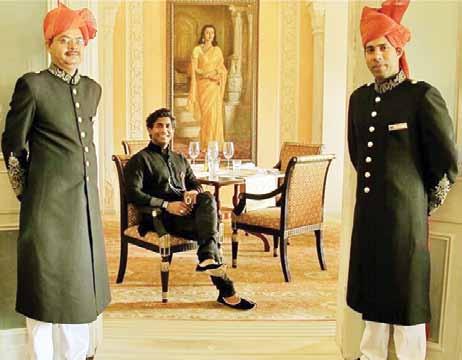
stay, my dad revealed a secret from his memory.
The Rajbari, Bawali (Heritage Hotel), Kolkata Interior of The Rajbari, Bawali, Kolkata
Just as in the novel A Suitable Boy by Vikram Seth, when my father was of marriageable age his family had a beautiful bride arranged for marriage for him, from the Mondal dynasty. He was against it. For many generations, this Mondol dynasty was custodian of The Rajbari Bawlia heritage property. After learning of that special connection, we attended the traditional rituals of Durga pujo festival inside The Rajbari Bawlia with other global in-house guests. We learned that love for heritage properties is a common connection between guests from across the globe.
The Durga Pujo traditional celebration in The Rajbari Bawlia continued, as we enjoyed typical Bengali culinary delights cooked by a local chef from Bihar and served in traditional terracotta plates. The Bay of Bengal tiger prawns from the Sundarbans in coconut red chilli curry was my favourite.
During Durga Pujo festive season, I also visited Marble Palace in North Kolkata. My visit opened up a world of art in the palace collection which included paintings of “Marine View" by Dutch painter Jan Van Goyen, "Madonna with Child" by Italian painter Giovanni Battista Salvi da Sassoferrato and “The Mystic Marriage of St. Catherine" by Rubens.
The Rajbari, Bawali (Heritage Hotel), Kolkata
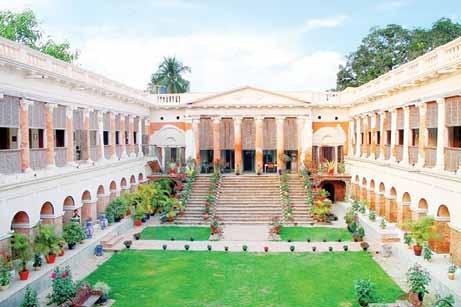
Marble Palace, North Kolkata
My visit to Marble Palace reminded me of my Murshidabad childhood days. During my childhood, I visited many palaces/rajbaris like Kathgola Bagan (Garden) Bari and Nasipur Rajbari and Hazarduari Palace in the region. Often the idea of staying in those heritage places did spring into my mind but was laughable in public. I always wanted to stay in my favourite Hazarduari Palace which was built and designed under the supervision of Colonel Duncan MacLeod of the Bengal Corps of Engineers. The foundation Stone was laid by the Nawab Nazim Humayun Jah of Bengal, Bihar and Orissa (1824–1838) on August 29, 1829. The thought of viewing the sunrise over the Ganges river from the palace balcony enchanted me the most.

Marble Palace, North Kolkata
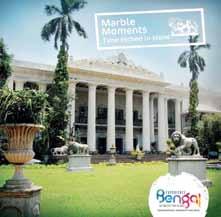
Kathgola Palace, Murshidabad
Interior of The Rajbari, Bawali, Kolkata
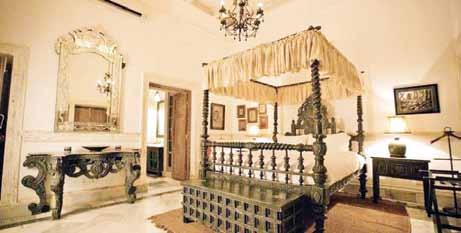
Kathgola Palace, Murshidabad
Today, the Murshidabad Heritage Festival showcases the history of the former capital of Bengal with idea of promoting heritage properties to the Indian tourist market. It is reported that the festival is looking at uplifting 97 heritage boutique properties, including glamorous Art Deco properties, neo-Gothic façades of palatial buildings and elegant garden bungalows with marble statues. The Murshidabad heritage uplifting project is in collaboration with both private and public sectors. This revival approach will assist the region to be on the global tourist map, earn tourist dollars and create a sustainable heritage tourism. It has significant social economic implications too. With Bengal Tourism Board and state road and railway authorities upgrading their infrastructures, Murshidabad Heritage Festival can only get better.
In 2018, John Zubrzycki , the author of The Last Nizam of Hyderabad wrote about Murshidabad, the former grand capital of Bengal , in The
Australian newspaper titled Once Was Glorious and it started saying “On the forlorn palaces clinging definitely to once-glorious past , half ruined mosques and the mildew covered tombstones of East India Company employees are reminders of an era when India’s Murshidabad was as large and rich as London.” The Murshidabad heritage uplifting project is in collaboration with both private and public sectors. The revival approach will only help the region to be in the global tourist map, earn tourist dollars and create a sustainable heritage tourism. It does have a significant social economic implication too. With Bengal tourism board and state road and railway authorities upgrading their infrastructures, Murshidabad Heritage Festival it can only get better.
The first ever Palace Day celebration on July 19 2020 in India can only enhance heritage tourism. This is the first time that Indian heritage properties have taken part in a global celebration. Palace Day first began in Europe in 2016 an initiative of the Palace of Versailles. The event was supported by UNESCO and the World Monuments Fund (WMF). It brings great collaboration opportunities between families and heritage of India and Europe to leverage their knowledge for a sustainable heritage tourism.
Palace Day marks the beginning of a new chapter for heritage properties of eastern India too. Amongst the 40 participating heritage properties in India, I found Belgadia Palace of Odisha and Cossimbazar Rajbari in Kolkata, West Bengal were the only participants from eastern India. This made no sense to me.
Cossimbazar Rajbari, Murshidabad, WB
According, to my understanding, there should be many more. History tells me that, if we go by the gun salutes given to the various royals of eastern India, there should be plenty of heritage properties. The Nawab Nazim of Bengal, Bihar and Orissa based in Murshidabad was granted a salute of 19-guns in 1838. As far as gun salutes of princely states is concerned Cooch Behar, in West Bengal got 13, Mayurbhanj in Odhissa got 9 and Darbhang in Bihar got 21 , whereas the royals of Sikkim got 15, Tripura got 13 and Manipur got 11. These princely states were heritage homes to the Maharajahs, Maharanis and Nawab Nizam. Eastern India also had significant wealthy Rai Bahadurs, Zamindars and traditional business tycoons who owned heritage properties. Archan Ghosh who is a travel enthusiast from London said, “I have heard about some of these heritage properties but have never visited them.” That would be the case for many of us non-resident Indians( NRI) living in London, NewYork or Sydney.
Mahisadal Rajbari, WB
My research on eastern India’s existing heritage properties made me feel that they have immense soft power to attract both local and foreign tourists across all age groups – but they have not been marketed properly. Rahul Singh from Shakarpura & Bahadurpur Estate in Bihar says, “Heritage tourism is the future, otherwise they will all collapse.’ During my research, I found the following heritage properties: 1. Anand Bagh Palace, Darbhang, Bihar 2. Krishnagarh Palace, Sultanganj, Bihar 3. Navlakha Palace, Madhubani, Bihar 4. Shakarpura & Bahadurpur Palace, Bihar 5. Kangla Palace, Manipur 6. Aul Palace, Lokapada, Odisha 7. Bolangir- Patana Palace, Odisha 8. Belgadia Palace, Odisha 9. Dalijoda Palace, Cuttack, Odisha 10. Gajlaxmi Palace, Dhenkanal, Odisha 11. Kalahandi Palace, Bhawanipatna, Odisha
Cossimbazar Rajbari, Murshidabad, WB

Mahisadal Rajbari, WB
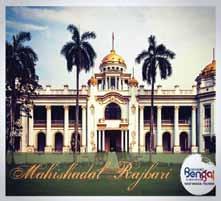
12. Mahodadhi Palace, Puri, Odisha 13. Sultan Palace, Patna, Odisha 14. Salia Shree Palace, Balangir, Odisha 15. The Belgadia Palace, Mayurbhanj Palace,
Odisha 16. Sonepur Palace, Odisha 17. Sikkim Palace, Sikkim 18. Ujjayanta Palace, Agartala, Tripua 19. Neer Mahal Palace, Tripura 20. Andul Palace, Andul, WB 21. Amadpur Zamindar Bari (Palace) Amadpur,
WB 22. Burdawan Rajbati or Mahatabmanjil, Burdawan, West Bengal (WB) 23. Bari Kothi, Singhi Kothi & Nowlakha
Kothi (Stately Home), Murshidabad, WB 24. Baganbati Palace, Chakdighi, WB 25. Bawali Rajbari , Bawali, WB 26. Dasghara Palace, Dhaniakhali,WB 27. Cossimbazar Palace, Murshidabad, WB 28. Dhanyakuria Palaces, Basirhat, WB 29. Dubey Palace, Haldia, WB 30. Hazarduari Palace, Murshidabad, WB 31. Hetampur Palace, Hetampur, WB 32. Itachuna Rajbari, Itachuna,WB 33. Jorasanko Rajbari, Kolkata, WB 34. Nasipur Palace, Murshidabad, WB 35. Nawab of Oudh Palace (Garden Reach BNR
House), Kolkata, WB 36. Narajole Rajbari, West Midnapur, WB 37. Kalikapur Zamindar Palace, Burdawan, WB 38. Kathgola Palace, Murshidabad, WB 39. Mahisadal Rajbari, Mahishadal, WB 40. Maheshganj Estate, Balakhana, WB 41. Marble Palace, Kolkata, WB 42. Rani Rashmoni Palace, Janbazar, Kolkata 43. Krishnanagar Palace, Krishnanagar,WB 44. Tamluk Palace,Medinipur, WB 45. Taki Rajbati, North 24 Parganas, WB 46. Jhargram Palace, Jhargram, WB 47. Panchkote Palace, Kashipur, WB 48. Victor Palace, Cooch Behar, WB 49. Surul Rajbari, Birbhum, WB 50. Sobhabazaar Rajbari, Kolkata, WB 51. Wasif Manzil Palace, Murshidabad, WB
Ujjayanta Palace, Agartala, Tripua

Ujjayanta Palace, Agartala, Tripua Anand Bagh Palace, Darbhanga, Bihar
If properly marketed, these heritage properties and their stories can definitely give Buckingham Palace a run for its money. There many be more heritage properties which I have not picked up as they might already be lost due to negligence. My search also took me across the border to Bangladesh, where there are three grand palaces that deserve mentioning, Natore Palace and Rose Garden Palace in Dhaka, and Puthia Rajbari in Rajshahi.
Some of these heritage properties have grand appearances, even though they have been utterly neglected due to lack of funds.
Mahisadal Rajbari, WB
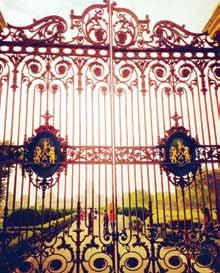
India’s revenue plummeted from 37.5 percent to 2 percent of the GDP during British rule, according to William Dalrymple, author of The Anarchy. To me, these heritage palaces are treasure troves of Indian cultures, customs and history. It is important for us to be able to identify them on the Indian tourist map. The realisation that eastern India can be a Mecca of heritage tourism is like opening a vast treasure trove.
Victor Palace, Cooch Behar , WB ( door)
Anand Bagh Palace, Darbhanga, Bihar
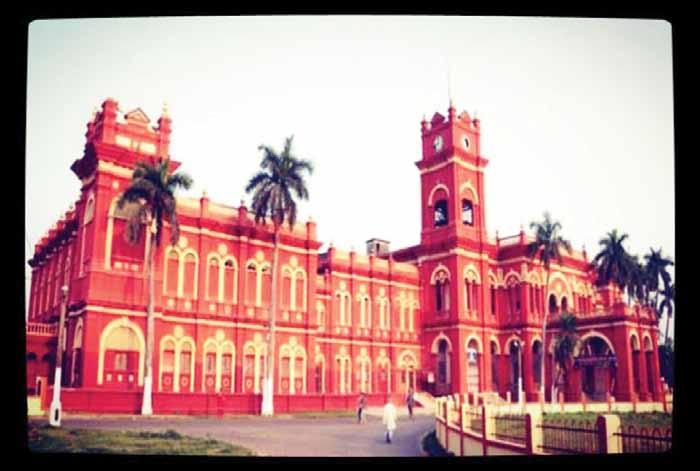


Divorce: How can you be eligible for getting a divorce?
By: Mitu Gopalan
Divorce is the formal legal ending of a marriage. It is totally separate and distinct from property arrangements following the breakdown of a marriage.
People usually get confused, thinking that divorce is linked to property settlement (including spousal maintenance), parenting orders and child support payments. This is not the case. Consider divorce to be merely the licence to re-marry.
To be able to get divorced you need to prove that your marriage has irrevocably broken down. This is confirmed when the parties have separated officially for 12 months or more, and can confirm that there is no likelihood of the relationship resuming.
Parties can be separated under the same roof, but cannot be in a physical relationship once they have separated.
To apply for a divorce, as outlined above, you must be separated for at least 12 months and you and your spouse must be:
1. Australian citizens, OR 2. Live in Australia and regard Australia as your permanent home, OR 3. Ordinarily live in Australia and have done so for at least 12 months before the divorce application.
Of course, if you have been married overseas, you can apply for a divorce in Australia as long as you meet the above criteria.
Kindly note however, if you have been married for less than 2 years, you must attend counselling with a family counsellor and file a counselling certificate giving you the exemption or get the permission from the court to apply for a divorce without the appropriate certificate being obtained (this would be in a scenario where there has been a significant case of domestic violence etc).
A divorce application can be filed for by one party or jointly.
How to apply:
You can be legally represented or proceed to self-represent if you wish to apply for a divorce. You need to apply to the Federal Circuit Court, (if located in Western Australia, you will need to apply through the Family Court of WA). You can apply together via a joint application or solely (a sole application). Depending on whether you have children under the age of 18, you will be asked to appear in court for the Final Hearing. There is a filing fee for the divorce application, and it is in the sum of $930.00.
Kindly note that after the Final Hearing, if the court is satisfied that all criteria is met, a divorce decree will be granted. However, you will not be issued with the same until one month and one day after the divorce hearing.
There is no time period in which a divorce must be applied for. However, you should take special note of the fact that as soon as a divorce decree is obtained, you need to obtain a resolution in relation to property settlement within 12 months. If an amicable resolution cannot be reached, you must apply to the court for property orders, as a time limit for the same expires 12 months after the date of divorce.












